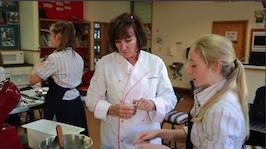Outcome development and evaluation
Outcome development and evaluation can be thought of as the design, production, and evaluative practices of the technological practice strand.
This component focuses on learning within three key stages:
- Design - the creative generation of design ideas that leads to the testing and refinement of these into a conceptual design for a potential outcome
- Production - the physical production and evaluation of the outcome prior to its acceptance for use in situ (where it was designed for). This is achieved through such things as research, experimentation, functional modelling, and prototyping.
- Evaluation - Analysis of evaluative data gained from functional modelling and prototyping, and the use of this to make informed and justifiable decisions for a potential and/or realised outcome, is critical to ensure that when the final outcome is produced, it is fit for purpose as defined by the brief.
Having an amazing idea is no use unless it can be communicated to others. This component supports students to develop effective presentation skills so they can collaborate with stakeholders when developing and sharing their conceptual ideas with others. Students progress in their capability to critically analyse their own ideas, and stakeholder feedback, as they strive to achieve their vision for their outcome.
Key ideas
Technological practices

The aim of most technological practice is a technological outcome (product or system) that meets the requirements of the brief. While there are situations in which development work ends before it gets this far, this component focuses on practices that take development through to production and final testing.
These practices involve generating and testing ideas, refining concepts, and selecting, producing, and evaluating outcomes. They include, for example:
- researching published research findings and analysing existing technological outcomes
- experimenting with different ways of communicating design ideas and working with materials
- learning to use appropriate equipment safely and skilfully
- using functional modelling to test design ideas before they are realised
- using prototyping to determine whether an outcome is fit for purpose or needs further development.
Functional modelling
A range of functional models (see Technological modelling) are used to test initial design ideas and refine a conceptual design.
Functional models are also important for communicating proposed outcomes to stakeholders and others. Conceptual ideas are presented using a range of suitable visual communication media so that those who are being asked for feedback can envisage what is proposed and provide relevant and informed comment. Stakeholder feedback is sought regularly and critically analysed so that it informs ongoing development.
Context-specific knowledge
High-quality outcomes require context-specific knowledge of materials and skills, including skills in the use of specialist equipment.
To ensure that an outcome is fit for purpose (in both the traditional and broadest senses) the student explores the performance properties of different materials, their aesthetic impact, accessibility, availability, and disposability.
Evaluation
The learning from evaluation feeds directly into ongoing planning. As a result of evaluation, initial plans will often be modified and resource projections revised.
Evaluative data also informs further development or refinement of the brief, often prompting students to reconsider what is actually needed to solve the issue/need.
Stakeholder feedback provides an evaluation of a technological outcome’s fitness for purpose prior to it being used in situ - the place and situation it was designed for.
Fitness for purpose in its broadest sense
If an outcome is to be truly successful, it will be considered fit for purpose in its broadest sense in the following ways:
- functional modelling should explore not only the suitability of the outcome itself but also how the student went about developing it;
- prototyping should prompt the student to evaluate the outcome within the wider context of the brief, including physical and social environments (where it is to be used and the people who will be using it) considering both how it will be used immediately and in the future.
Outcome development and evaluation: Key ideas (Word 2007, 140 KB)
Acknowledgment: This paper is derived from an earlier version by Dr Vicki Compton and Cliff Harwood.
